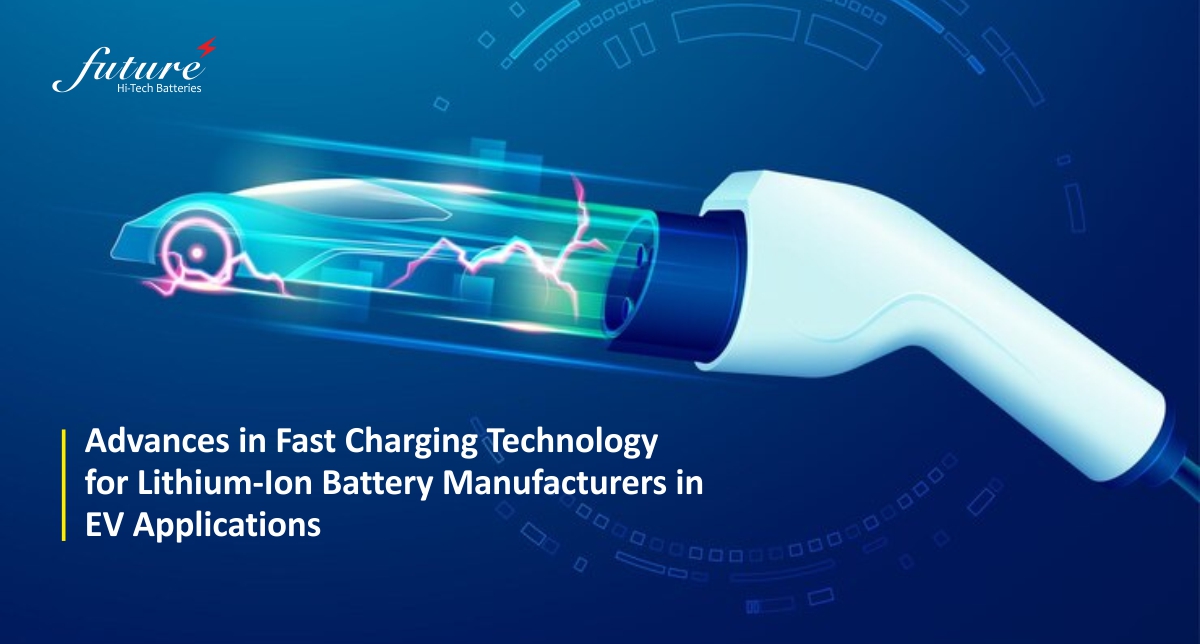The global shift towards electric vehicles (EVs) has undeniably gained momentum over the past decade. As a result, the automotive industry is actively searching for innovative solutions to address the inherent challenges of EVs, one of which is the time it takes to charge the vehicle’s lithium-ion battery. Fast charging technology has emerged as a beacon of hope, promising to revolutionize EV adoption by drastically reducing charging times. In this article, we’ll delve into the advances in fast charging technology for lithium-ion battery manufacturers in the realm of EV applications.

Lorem ipsum dolor sit amet, nec in adipiscing purus luctus, urna pellentesque fringilla vel, non sed arcu integer, mauris ullamcorper ante ut non torquent.
The Need for Speed
Electric vehicles have taken the automotive industry by storm, offering a sustainable and environmentally friendly alternative to traditional internal combustion engine vehicles. However, the charging time required for EVs has been a significant hurdle, often cited as a point of concern for potential buyers. Unlike the rapid refueling of a gasoline or diesel vehicle, recharging an EV has typically taken much longer, leading to “range anxiety” and hesitation among consumers.
To overcome this obstacle, manufacturers, researchers, and engineers have embarked on a quest to develop faster and more efficient charging solutions for lithium-ion batteries in EVs.
High-Energy Density Batteries
A fundamental advancement in fast charging technology for EVs lies in the development of high-energy density lithium-ion batteries. These batteries can store more energy while maintaining their ability to charge rapidly. One of the notable developments in this area is the use of advanced electrode materials.
For example, nickel-rich cathode materials have gained prominence in recent years. These materials offer a higher energy density compared to traditional cobalt-based cathodes, allowing for both greater range and faster charging times. EVs equipped with nickel-rich lithium-ion batteries can be charged more quickly while still delivering impressive driving ranges.
Moreover, silicon-based anodes have emerged as a promising option to boost energy density. Silicon anodes can store significantly more lithium ions than traditional graphite anodes. While silicon anodes present challenges related to volume expansion during charge and discharge cycles, researchers are actively working on mitigating these issues to harness their full potential.
Advanced Cooling Systems
Fast charging generates a considerable amount of heat within lithium-ion batteries. Managing this heat is critical to ensuring the safety and longevity of the battery pack. Advanced cooling systems have thus become an essential component of fast charging technology for EVs.
Innovations in cooling solutions include liquid cooling, air cooling, and even phase-change materials that can absorb and dissipate heat efficiently. These cooling systems not only regulate the battery’s temperature during fast charging but also enable repeated fast charging without significant degradation.
Additionally, some manufacturers are exploring “active” cooling systems, which use fans or other mechanisms to enhance heat dissipation further. These systems help maintain a consistent temperature within the battery pack, allowing for more predictable and faster charging.
High-Power Charging Infrastructure
Fast charging technology extends beyond the batteries themselves. The development of a high-power charging infrastructure is equally crucial for widespread EV adoption. High-power charging stations, often referred to as DC fast chargers, can deliver significantly higher charging rates compared to standard residential chargers.
These charging stations are equipped with cutting-edge power electronics and advanced cooling systems to handle the increased power output required for fast charging. Some stations can provide an EV with enough charge for a substantial portion of its range in as little as 15-30 minutes, making long-distance EV travel much more feasible.
Additionally, the widespread adoption of standardized connectors like the CCS (Combined Charging System) and CHAdeMO has streamlined the fast charging experience for EV owners. These connectors ensure compatibility across various EV models, making it easier for consumers to access fast charging infrastructure.
Battery Thermal Management
Battery thermal management (BTM) systems are integral to fast charging technology for EVs. These systems control the temperature of the battery pack during charging to ensure safe and efficient operation.
Advanced BTM systems employ a combination of active and passive cooling techniques. Liquid cooling, for instance, circulates a coolant through a network of channels in the battery pack, dissipating heat effectively. Additionally, BTM systems utilize advanced sensors and algorithms to monitor and adjust temperature conditions in real-time, optimizing the charging process for speed and safety.
Moreover, researchers are exploring the integration of phase-change materials into BTM systems. These materials can absorb and release heat as they change from solid to liquid and vice versa, helping to regulate temperature fluctuations during fast charging.
Intelligent Battery Management Systems
Intelligent Battery Management Systems (BMS) play a pivotal role in the success of fast charging technology for EVs. These systems monitor and control various aspects of the battery’s operation, including state of charge, state of health, and temperature.
Advanced BMS solutions incorporate artificial intelligence (AI) and machine learning (ML) algorithms to optimize the charging process. These algorithms can adapt to the specific needs of the battery and the user, ensuring that the battery is charged as rapidly as possible without compromising safety or longevity.
Furthermore, AI-powered BMS can predict and prevent potential issues, such as overheating or overcharging, which can degrade the battery’s performance over time. By continuously learning from the battery’s behavior, AI-driven BMS enhances both the fast charging experience and the overall lifespan of the battery pack.
Future Prospects
The world of fast charging technology for lithium-ion batteries in EV applications is poised for continuous growth and innovation. Several promising avenues are on the horizon:
a) Ultra-fast charging: Researchers are actively exploring the possibilities of ultra-fast charging, with the goal of reducing charging times to a few minutes. While significant challenges remain, such as managing extreme heat generated during such rapid charging, progress in this area is anticipated.
b) Solid-state batteries: Solid-state batteries have garnered considerable attention for their potential to revolutionize fast charging in EVs. These batteries replace traditional liquid electrolytes with solid electrolytes, offering increased energy density and faster charging capabilities. The development of solid-state batteries is an ongoing area of research and development.
c) Wireless fast charging: Wireless charging technology for EVs is advancing rapidly. High-power wireless charging systems are being developed to offer convenient, fast charging without the need for physical connectors. This technology could redefine the EV charging experience.
d) Grid integration: As fast charging becomes more prevalent, integrating it into the electrical grid effectively will be crucial. Smart grid solutions and demand response programs will play a vital role in optimizing the use of fast charging stations, reducing peak power demand, and enhancing grid stability.
The relentless pursuit of faster charging technology for lithium-ion batteries in EV applications is driving the transformation of the automotive industry. Advances in high-energy density materials, advanced cooling systems, high-power charging infrastructure, battery thermal management, intelligent battery management systems, and more are converging to reshape the future of EVs.
As the global shift towards sustainable transportation accelerates, consumers can look forward to shorter charging times, increased convenience, and a seamless transition to electric vehicles. With ongoing research and innovation, the prospect of ultra-fast charging and solid-state batteries holds the potential to further revolutionize the EV landscape, making electric mobility an even more attractive and practical choice for consumers worldwide.
The Feasibility of Ultra-Fast Charging Networks for Lithium-Ion Batteries
The race to develop ultra-fast charging networks for lithium-ion batteries is a critical component of the transition towards electric mobility. Ultra-fast charging promises to reduce charging times dramatically, addressing one of the primary concerns of electric vehicle (EV) adoption – long charging waits. While the idea of ultra-fast charging networks is enticing, assessing their feasibility requires a closer look at various technological, infrastructure, and economic factors.
Technological Advancements
One of the primary drivers behind the feasibility of ultra-fast charging networks is the continuous advancement of lithium-ion battery technology. Batteries with higher energy density and improved thermal management systems are essential for supporting ultra-fast charging. Fortunately, research and development efforts have made substantial progress in this regard.
Materials like nickel-rich cathodes and silicon-based anodes are being incorporated into lithium-ion batteries, boosting energy density and allowing for faster charging without overheating. Additionally, advanced battery management systems (BMS) powered by artificial intelligence are being deployed to optimize the charging process further.
Furthermore, ongoing research into solid-state batteries holds great promise. Solid-state batteries, which replace the liquid electrolyte with a solid one, offer higher energy density, faster charging capabilities, and enhanced safety features. Although they are not yet widely commercialized, their development could significantly impact the feasibility of ultra-fast charging networks.
Infrastructure Development
Feasibility also hinges on the deployment of a robust charging infrastructure capable of delivering high-power charging to a wide range of EVs. This infrastructure encompasses charging stations, electrical grid enhancements, and standardized connectors.
High-power charging stations, often referred to as DC fast chargers, are essential for delivering the rapid charging capabilities required for ultra-fast charging. These stations are equipped with advanced power electronics, cooling systems, and secure payment mechanisms. The widespread availability of such stations is essential for ensuring the feasibility of ultra-fast charging networks.
Moreover, integrating ultra-fast charging networks into the existing electrical grid is a complex but critical step. It involves upgrading grid infrastructure to handle the increased power demand during peak charging periods. Smart grid solutions, demand response programs, and energy storage systems can help balance grid loads and optimize the use of fast-charging stations.
Standardized connectors, such as CCS (Combined Charging System) and CHAdeMO, ensure interoperability across different EV models, simplifying the charging process and enhancing the feasibility of ultra-fast charging networks.
Economic Considerations
The feasibility of ultra-fast charging networks is closely tied to economic factors, including cost, revenue generation, and return on investment (ROI). Developing and maintaining a widespread network of high-power charging stations is a substantial investment.
Charging station operators must consider factors such as equipment costs, installation expenses, land acquisition, and ongoing maintenance. However, these costs can be offset by factors such as usage fees, subscription models, and partnerships with EV manufacturers.
Another aspect to consider is the potential for revenue generation beyond charging fees. Charging stations can offer various services, including retail partnerships, advertising opportunities, and data analytics. These additional revenue streams can contribute to the feasibility of ultra-fast charging networks.
Government incentives and subsidies can also play a significant role in making these networks economically viable. Many governments worldwide are offering incentives to encourage the development of EV infrastructure, including fast charging stations.
Consumer Adoption
The feasibility of ultra-fast charging networks is ultimately dependent on consumer adoption and acceptance of electric vehicles. Faster charging times are a compelling selling point for EVs, and as more consumers embrace electric mobility, the demand for ultra-fast charging will grow.
Consumer behavior and charging patterns are essential considerations for infrastructure planning. Charging stations need to be strategically located along major highways, urban centers, and areas with high EV adoption rates. Ensuring easy access to ultra-fast charging can help drive consumer adoption and, in turn, the feasibility of these networks.
The feasibility of ultra-fast charging networks for lithium-ion batteries in the context of electric mobility is a complex and multifaceted issue. Technological advancements, infrastructure development, economic considerations, consumer adoption, and environmental impact all play pivotal roles in determining whether these networks can become a reality.
While significant progress has been made in battery technology and charging infrastructure, there are still challenges to overcome. Ongoing research into high-energy density materials, solid-state batteries, and smart grid solutions will continue to shape the feasibility of ultra-fast charging networks. Economic factors and government support will also influence the development and expansion of these networks.
Ultimately, the feasibility of ultra-fast charging networks is intrinsically linked to the demand for electric vehicles and the willingness of consumers to embrace electric mobility. As the EV market grows and technology continues to evolve, the vision of ultra-fast charging becoming a ubiquitous reality is increasingly within reach.










Your Comment Please